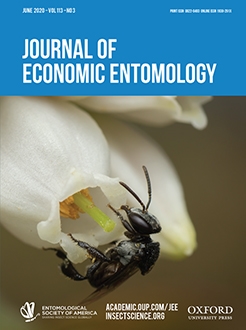Climate change has been linked to shifts in the distribution and phenology of species although little is known about the potential effects that extreme low winter temperatures may have on insect host–parasitoid interactions. In late January 2019, northern regions of the United States experienced a severe cold wave caused by a weakened jet stream, destabilizing the Arctic polar vortex. Approximately 3 mo later at six study sites in southern Michigan and three in southern Connecticut, we sampled the overwintering larvae of the emerald ash borer, Agrilus planipennis Fairmaire (Coleoptera: Buprestidae), and two larval parasitoids, Spathius galinae (Hymenoptera: Braconidae) and Tetrastichus planipennisi (Hymenoptera: Eulophidae), that are being introduced as emerald ash borer biocontrol agents in North America. At these nine study sites, emerald ash borer-infested ash trees and/or saplings were debarked and each overwintering emerald ash borer and parasitoid larva was then examined for cold-induced mortality, as indicated by a brown coloration, flaccid, and watery consistency. In early spring in Michigan, we found 4.5–26% of emerald ash borer larvae, 18–50% of S. galinae larvae, and 8–35% of T. planipennisi larvae were killed by cold. In Connecticut where temperatures were more moderate than in Michigan during the 2019 cold wave, <2% of the larval hosts and parasitoids died from cold injury. Our findings revealed that cold-induced mortality of overwintering larvae of emerald ash borer and its larval parasitoids varied by location and species, with higher mortality of parasitoid larvae in most Michigan sites compared to host larvae. The potential impacts of our findings on the management of emerald ash borer using biocontrol are discussed.
How to translate text using browser tools
4 April 2020
Effects of Extreme Low Winter Temperatures on the Overwintering Survival of the Introduced Larval Parasitoids Spathius galinae and Tetrastichus planipennisi: Implications for Biological Control of Emerald Ash Borer in North America
Jian J. Duan,
Leah S. Bauer,
Roy Van Driesche,
Jonathan M. Schmude,
Toby Petrice,
Jennifer L. Chandler,
Joe Elkinton
ACCESS THE FULL ARTICLE
It is not available for individual sale.
This article is only available to subscribers.
It is not available for individual sale.
It is not available for individual sale.

Journal of Economic Entomology
Vol. 113 • No. 3
June 2020
Vol. 113 • No. 3
June 2020
biological control
climate change
extreme cold weather
invasive
overwintering




